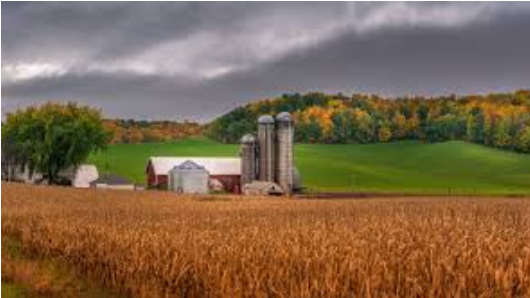Farming and agricultural operations are vital to feeding the world, but they come with their own set of challenges, particularly when it comes to fire hazards. The combination of dry crops, machinery, and storage facilities can create a highly combustible environment, making fire prevention a top priority for farmers. By understanding the common causes of agricultural fires, obtaining a Fire Alarm Testing Certificate, and implementing effective prevention strategies, farms can protect their assets, workers, and the surrounding environment.
Common Causes of Fire in Agriculture
Understanding the common causes of fire in agricultural settings is the first step toward prevention. Fires can originate from various sources, including machinery, electrical systems, spontaneous combustion, and even natural causes like lightning. Identifying these risks allows farmers to take targeted actions to mitigate them.
Machinery and Equipment
Farm machinery, including tractors, harvesters, and balers, are essential for daily operations but can also be significant fire hazards. These machines generate heat during use, and if not properly maintained, they can ignite nearby dry crops or combustible materials. Overheated engines, friction from moving parts, and electrical faults are common culprits. Regular maintenance, including cleaning, lubrication, and inspection of electrical systems, is crucial to prevent machinery-related fires.
Electrical Systems
Electrical systems in barns, storage facilities, and other farm structures can pose a fire risk if not properly installed and maintained. Faulty wiring, overloaded circuits, and outdated electrical equipment can spark fires. Ensuring that electrical installations meet safety standards and are inspected regularly can significantly reduce this risk. Additionally, installing surge protectors and using equipment designed for agricultural environments can help prevent electrical fires.
Spontaneous Combustion
Spontaneous combustion occurs when organic materials, such as hay, straw, or compost, generate heat through microbial activity. If these materials are stored in large quantities and not adequately ventilated, the heat can build up to the point of ignition. Proper storage practices, including drying materials before storage, regularly monitoring temperature, and ensuring good ventilation, can help prevent spontaneous combustion.
Natural Causes
Lightning strikes and wildfires are natural causes of fire that can threaten agricultural operations. While these are less controllable, farmers can take measures to reduce their impact. Creating firebreaks, maintaining vegetation around farm structures, and having a fire emergency plan in place can help mitigate the damage caused by natural fires.
Fire Prevention Strategies
Preventing fire hazards in agriculture requires a proactive approach, combining good practices, regular maintenance, and emergency preparedness. Implementing the following strategies can help safeguard farms from fire-related disasters.
Regular Maintenance of Machinery and Equipment
Regular maintenance of farm machinery is essential to prevent fire hazards. This includes cleaning debris from machinery after use, checking for worn or damaged parts, and ensuring that cooling systems are functioning correctly. Regular oil changes and lubrication of moving parts can reduce friction and the risk of overheating. Additionally, machinery should be stored in well-ventilated areas, away from combustible materials, to reduce the risk of accidental ignition.
Proper Storage of Combustible Materials
The storage of combustible materials like hay, straw, and fertilizers requires careful planning. These materials should be stored in dry, well-ventilated areas, away from potential ignition sources such as machinery or electrical equipment. Monitoring the temperature of stored materials can help detect early signs of spontaneous combustion. If heating is detected, the materials should be spread out to cool down and re-evaluated before being restacked.
Safe Electrical Practices
Electrical systems should be designed, installed, and maintained by qualified professionals who understand the unique challenges of agricultural environments. Regular inspections can help identify potential hazards like frayed wires, overloaded circuits, or faulty equipment. Farmers should also ensure that all electrical outlets, switches, and fixtures are suitable for outdoor or agricultural use, as these are more resistant to moisture and dust.
Creating Firebreaks and Maintaining Vegetation
Firebreaks are gaps in vegetation that act as barriers to slow or stop the spread of fire. By creating firebreaks around farm structures, fields, and storage areas, farmers can reduce the risk of fire spreading across the property. Additionally, maintaining vegetation by regularly cutting grass, trimming trees, and clearing brush can help minimize fuel for fires.
Emergency Preparedness and Training
Having a fire emergency plan is crucial for minimizing the impact of a fire if one occurs. This plan should include clear procedures for evacuating workers, contacting emergency services, and using fire extinguishers or other firefighting equipment. Training farm workers on fire prevention, detection, and response is equally important. Workers should know how to operate firefighting equipment, recognize fire hazards, and respond quickly in an emergency.
Fire Detection and Suppression Systems
Installing fire detection and suppression systems in key areas of the farm can provide early warning and help contain fires before they spread. Smoke detectors, heat sensors, and fire alarms should be placed in barns, storage facilities, and near machinery. In addition, automatic sprinkler systems or fire suppression systems can be installed to quickly douse flames in the event of a fire. Regular testing and maintenance of these systems are essential to ensure they function correctly when needed.
Special Considerations for Harvest Season
Harvest season is a particularly high-risk time for fire hazards on farms. The combination of dry crops, increased machinery use, and busy schedules can create a perfect storm for fires. During this time, it’s essential to take extra precautions to reduce fire risks.
Increased Vigilance
Farmers should increase vigilance during harvest season, ensuring that all machinery is in good working order and free of debris that could ignite. It’s also a good idea to have fire extinguishers readily available on all machinery and in strategic locations around the farm. Workers should be reminded of fire safety procedures and the importance of staying alert to potential hazards.
Controlled Burns and Open Flames
Controlled burns are sometimes used to manage crop residue or prepare fields for the next planting season. However, these burns should be conducted with extreme caution, following all local regulations and safety guidelines. Open flames, such as those from welding or bonfires, should be avoided during harvest season, as they can easily ignite dry crops or stubble.
Conclusion
Preventing fire hazards in agricultural and farming operations requires a comprehensive approach that includes regular maintenance, proper storage practices, safe electrical use, and emergency preparedness. By understanding the common causes of fire and implementing targeted prevention strategies, farmers can protect their livelihoods, workers, and the environment from the devastating effects of fire. For added safety, consulting experts like London Property Inspections can be beneficial in ensuring that all aspects of fire prevention are thoroughly addressed. The proactive measures taken today can prevent tragedies tomorrow, ensuring the safety and sustainability of agricultural operations for future generations, If you want to stay updated with posts like this, please follow us on ITS RELEASED.


